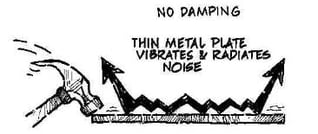Just about everything that has been engineered is likely to experience vibration. Unfortunately, it has been proven that vibration can be responsible for causing extreme damage to some applications. The source of vibration can come from impact, internal motors or external sources.
Vibration Damping vs. Vibration Isolation - What's the Difference?
Vibration happens all around us whether we know it or not. Sometimes it’s evident when you hear buzzing, squeaking, or rattling noises such as when you run your noisy washing machine or dish washer. Other times you may notice the sensation of vibration when you are driving a car over a bumpy road or when you see the cables on a bridge shaking back and forth on a windy day. Most of us experience the harsh impact of an object when we drop our cell phones on the solid ground.
Fortunately, there are material solutions for all this vibration madness. Vibration damping and vibration isolation are two effective forms of vibration control for structure borne vibrations and sound.
Vibration damping is used when the frequency of vibration cannot be lowered at the source of the object. The purpose of vibration damping is to absorb and dissipate the vibrations of an object, which in turn reduces the noise. The damping method is often used in instances where one does not anticipate repeated shock or impact of an object.
Vibration isolation, on the other hand, isolates an object from the source causing the vibration. Therefore, vibration isolation prevents vibrations from making direct contact with the object. This method is utilized when the object is subject to enduring constant vibrations and continuous impact. Often, an application that experiences vibration will benefit from using both methods of vibration control.
Vibration Damping Vibration Isolation



Material Solutions for Vibration Management
Marian Inc. engineers are experts in managing shock and vibration control. We recommend that you check out Rogers' PORON® Urethanes or BISCO® Silicones when deciding on a material solution for vibration management. Rogers' materials are designed to damp or isolate structure borne vibration before they become noise.
For more robust applications, Roger's Isolation Efficiency Calculator tool uses your system specifications to calculate the isolation efficiency of Rogers' heavy duty VXT materials and provides you with the most effective material option for your application. We also recommend investigating 3M E-A-R products to assist you in providing a solution for the vibration complications that your application is experiencing.
Let Marian Help with Your Die-Cut Vibration Control Solutions
Marian die-cuts specialty foams and silicones of different thicknesses to fit the requirements of your specific application. Check out some of the vibration reducing materials we use for our customers' custom applications.
Contact us to discuss solutions for your complex vibration issues. We'll put you in touch with a Sales Engineer in your area that will provide material recommendations and work with you to find a solution to remedy the vibration issues you are experiencing.



